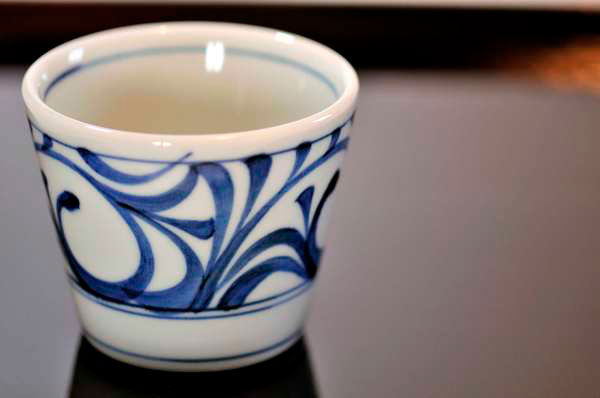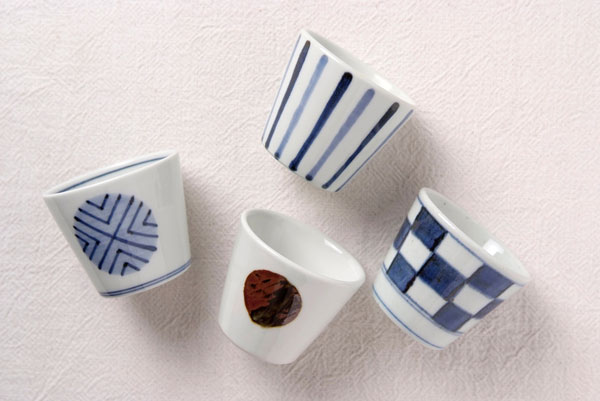
- Ceramic
- Ehime
Tobe ware Tobe yaki
Fine, delicate patterns
handmade using traditional techniques
Description
What is Tobe ware ?
Tobe ware (called Tobe yaki in Japanese) is a form of ceramic ware produced around the town of Tobe in Iyo district of Ehime prefecture. Production began in the middle of the Edo period (1603-1868) and it was registered as a traditional craft by the Ministry of Economy, Trade and Industry in 1976. The town of Tobe is known for being the leading ceramic ware producing area in the Shikoku region, being located in the pottery material abundant Japanese Median Tectonic Line*. As high quality porcelain stone started being mined in mountainous regions, ceramic culture spread and many kilns remain in operation today. What makes Tobe ware unique is its beautiful white ceramic texture, which appears to let light pass through. Compared to Arita ware (made in Saga prefecture), the white ceramic texture of Tobe ware has a slight touch of gray. Because coloring of the ceramic ware changes depending on the amount of iron in the porcelain stone, Tobe ware artisans have come up with solutions like improving the glaze or having design artisans hand draw a pattern. Tobe ware continues to be loved by people as it is a handmade ceramic ware that is easy to use in the home.
*Also known as the Median Tectonic Line, it is Japan's longest fault systems.
History

Tobe ware was established in 1777, when the Ozu domain in what is today Iyo district independently began to study ceramic ware. Originally, a whetstone called iyoto was the local specialty but as the resource was rare and not much could be made, Tobe ware was developed with the scraps of Iyo whetstones. During the Edo period (1603-1868), Tobe ware was produced independently since there was limited information from other domains. After the abolition of feudal domains and the establishment of prefectures in 1871 during the Meiji period (1868-1912), it became possible to import technology from famous production areas such as Karatsu and Seto which led Tobe ware to expand rapidly. As technology started to make mass production possible, Tobe ware expanded its market into Southeast Asia. Then during the Taisho period (1912-1926) and Showa period (1926-1988), porcelain producing areas such as Seto increased their production volume by adopting modern technology like mechanical potter's wheels, leading the handicraft Tobe ware to stagnate. However, Muneyoshi YANAGI (1889-1961), a philosopher known for his folk art movement (Mingei) which was dedicated to rescuing lowly pots used by commoners, valued its high quality handicraft technique. Even today, the fascination with Tobe ware has not faded.
General Production Process
- 1. Clay production The first step is extracting clay from a quarry. In the area around Tobe, porcelain stones containing high iron content are mined often, and trachyandesite (a type of rock dominated by feldspar) from the Uebi mountain ridge are used as raw material. Once the porcelain stone has been quarried, the stones are sorted while removing low quality pieces by crushing them into tiny pieces. Then a process called elutriation is done to purify the porcelain stone by making use of specific gravity difference. Moisture is removed, clay is added, and the porcelain clay is complete. At this time, it is also crucial to remove iron from the porcelain stone with a magnet. The porcelain stone is pulverized for over 25 to 45 hours with a magnet called a "ball mill". Once it is ground to a fine powder, the porcelain stone is put into a filter press where impurities are removed for approximately two hours and pure potter's clay is finally complete.
- 2. Clay production and kneading
A clay kneading machine is used to knead the potter's clay into a uniform hardness.
This work is carried out thoroughly to remove air bubbles from the soil and prevent holes from forming during baking.
Before the mechanization, clay was kneaded by hand. It is said that it took at least three years for an apprentice to learn this technique.
- 3. Potter's wheel shaping Potter's wheel shaping is often used as a method of shaping. Since potter's clay from Tobe is hard and not softened by adding water, shaping requires strength. The way to use a potter's wheel is by placing clay onto the potter's wheel and then striking it by hand so that the clay stays in the center. The next process is "coning up and down" which involves kneading while the potter's wheel is rotating and moving the clay up and down. Next, in a process known as clay removal, unnecessary clay is cut off so that the clay is constricted as much as possible. A gauntlet or spatula is used as a tool for shaping and a surface gauge is used to adjust the size. A piece of tanned leather is used for finishing and a potter's wire is often used for removing pieces from the base. Finally, the whole surface of the pottery gets shaved with a kanna or Japanese plane. Other types of shaping that are done include hand-building, slip casting where clay is poured into a plaster mold, string molding, and slab building. Once shaping has been done and the piece is half dried, decorations are engraved. In order to prevent cracks on the vessel, it is important that the pieces are dried thoroughly before moving on to the bisque process.
- 4. Bisque After checking that there are no cracks, the pots are lined up inside the kiln. When the temperature reaches 950℃ (about 1742℉) after 18 hours, the pottery is fired for about two hours at this temperature, and after that, they are baked while reducing the temperature.
- 5. Underglaze decoration Underglaze decoration is the process of hand drawing patterns on the item. After the glost firing, the parts where patterns have been drawn with a special pigment called gosu (zaffer) turn indigo.
- 6. Glazing The decorated vessels are then glazed.
- 7. Glost firing The final process is glost firing. Pots are fired for 15 to 24 hours at 1300℃ (about 2372℉). They are removed from the kiln after being cooled thoroughly and are complete.
Where to Buy & More Information
Isobeyaki Togeikan
-
Address
-
Tel.+81-89-962-3900
-
ClosedWednesdays (open if Wednesday is a holiday)
-
Business Hours9am to 5pm
-
Website
See more Ceramic
- Imari ware/Arita ware
- Hasami ware
- Kutani ware
- Mashiko ware
- Shigaraki ware
- Bizen ware
- Hagi ware
- Koishiwara ware
- Mino ware
- Tobe ware
- Tokoname ware
- Karatsu ware
- Kasama ware
- Satsuma ware
- Iga ware
- Mikawachi ware
- Agano ware
- Otani ware
- Obori-soma ware
- Tsuboya ware
- Aizu-hongo ware
- Shodai ware
- Echizen ware
- Akazu ware
- Tamba-tachikui ware
- Yokkaichi-banko ware
- Izushi ware
- Kyo ware/Kiyomizu ware
- Iwami ware
- Amakusa ceramics
- Seto-sometsuke ware
- Sanshu Onigawara Crafts































































































































































































































































































